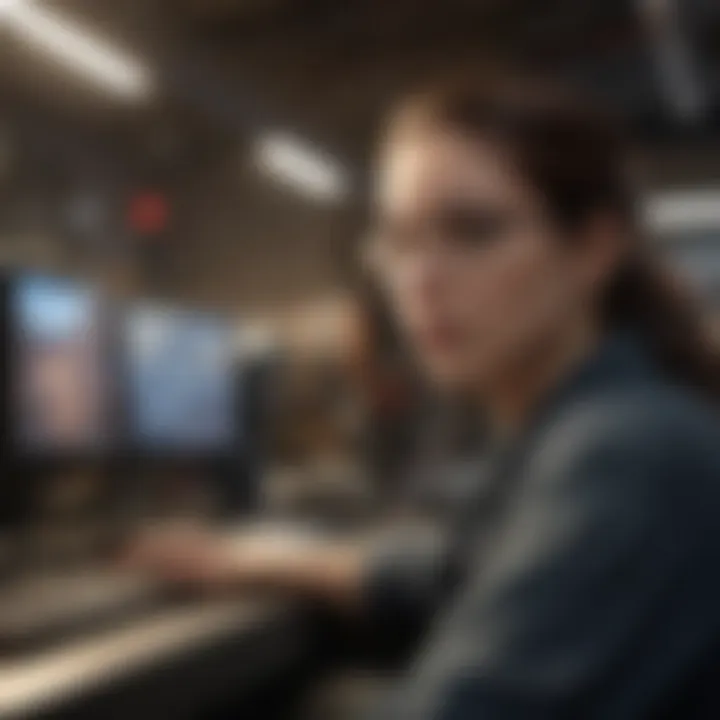Exploring a Major in Computer Graphics: An Academic Journey


Intro
Computer graphics is a multifaceted discipline emerging at the intersection of art and technology. This field explores the creation, manipulation, and representation of visual images through computational tools. In today’s digital age, computer graphics influence various sectors, including entertainment, education, and design.
This article aims to unpack the academic journey of majoring in computer graphics. It seeks to elucidate the core concepts, the curriculum structure, and the various career pathways available to graduates in this domain. The journey will guide students, researchers, educators, and professionals, offering a detailed understanding of what to expect and how to navigate this rapidly evolving field.
Preface to Computer Graphics
Computer graphics encompass a vital aspect of modern technology and art, serving as a bridge between complex data and visual representation. Understanding this field is essential for students and professionals alike, as it integrates technical skills with creative expression. The importance of this study lies in the ability to convey ideas, emotions, and intricate processes through visual formats, making information more accessible and engaging.
Definition and Scope
Computer graphics is essentially the study of how to digitally create and manipulate visual content. This can include everything from 2D illustrations to architecturally complex 3D models. The scope of computer graphics is broad; it spans entertainment, education, virtual reality, and scientific visualization. It involves various elements such as rendering, shading, and animation, allowing for a diverse range of applications.
One key element within computer graphics is rendering, which refers to the process of generating an image from a model by means of computer programs. This can be achieved through different techniques like ray tracing or rasterization. Moreover, the scope extends into user interface design, where the presentation of information plays a crucial role in user experience.
Understanding the definition and scope of computer graphics helps students focus their studies on critical areas, guiding them to specialize in fields that align with their interests and career goals.
Historical Perspective
The history of computer graphics is rich and multifaceted, beginning with early innovations in the 1960s. Initially, these graphics were simplistic, often used for scientific and mathematical purposes. As technology advanced, the field matured rapidly. In the late 1970s, computer-generated imagery (CGI) became prominent in film and television, influencing both art and technology.
One notable milestone was the release of the movie "Tron" in 1982, which showcased extensive use of computer graphics and influenced future filmmakers. The development of tools like Adobe Illustrator and AutoCAD further revolutionized how artists and architects visualized their ideas.
The historical journey of computer graphics is not just about technological advancements; it reflects changing cultural trends. Each milestone brought new opportunities, leading to a more visually interconnected world. Consequently, understanding this history equips students with a contextual framework for their studies, illustrating how past innovations shape current methodologies and future directions.
The Importance of Computer Graphics
Computer graphics is a pivotal field that influences a wide array of industries and creative practices. In this digital age, the ability to create, manipulate, and visualize images on computers has become essential. As technology advances, the importance of computer graphics continues to grow, impacting everything from entertainment to education, healthcare, and beyond.
Impact on Various Industries
The influence of computer graphics extends far beyond the confines of art and design. Numerous industries rely on this technology to enhance their operations and improve their products. For example:
- Gaming: The gaming industry is a prime example of computer graphics at work. Stunning visuals and intricate animations create immersive experiences. Games like "The Last of Us" utilize advanced graphical techniques to deliver emotional storytelling and lifelike characters.
- Film and Animation: In film production, computer graphics play a crucial role in creating visual effects. Movies such as "Avatar" and "Jurassic Park" utilized groundbreaking graphics technology to bring fantastical worlds and creatures to life. Animation studios employ computer graphics for character design and compositing.
- Architecture and Engineering: Architects and engineers utilize computer graphics to produce detailed models and simulations. Tools like AutoCAD and SketchUp allow professionals to visualize structures before construction, improving client communication and design accuracy.
- Healthcare: In medical fields, graphics are essential for visualizing complex data. MRI scans and 3D models assist doctors in diagnosing conditions. Moreover, training simulates real-life scenarios in surgery or diagnostics, enhancing learning outcomes.
The symbiotic relationship between computer graphics and these industries highlights its vital importance. The ability to present information clearly and attractively is indispensable.
Role in Storytelling and Visual Communication
Computer graphics also serve as a powerful medium for storytelling. Visual storytelling leverages the strength of graphics to convey complex ideas quickly and effectively. Here are key ways it enhances imaginative narratives:
- Engagement: Visual elements capture attention better than text alone. A compelling visual narrative can draw the viewer in; this is fundamental in advertising and marketing strategies. Brands using intricate infographics or striking animations can effectively communicate their message.
- Accessibility: Complex concepts benefit from visual simplification. Infographics, for instance, allow viewers to digest data easily. This is especially beneficial in educational settings where visual aids can enhance learning.
- Creativity: Graphic designers infuse creativity into their work. Their designs evoke emotions and set tones, greatly impacting how stories are perceived. This is vital in film and game industries where visuals play an instrumental role in defining the audience's experience.
In summary, computer graphics are more than just visual enhancement. Their ability to transform industries and improve communication transcends barriers, enriching our experiences and understanding of diverse fields. The exploration of computer graphics is not only about technical skills; it encapsulates creative envisioning in a tech-savvy world.
"Computer graphics is about transforming information into images, conveying narratives in innovative ways."
This dynamic nature of computer graphics ensures its continued significance as we forge ahead into an increasingly digital future.
Curriculum of a Computer Graphics Major
The curriculum for a Computer Graphics major is critical for anyone pursuing this academic path. It serves as the framework guiding students through essential knowledge and skills required in the field. Here, students not only learn technical skills but also develop a creative mindset that is necessary for innovation in visual media.
A well-structured curriculum consists of both core and elective courses, providing a rounded education tailored to diverse interests and career goals within the field. Understanding these components is vital for students to select the most appropriate academic path to suit their aspirations.
Core Courses
Core courses in a Computer Graphics major lay the foundation for students by covering fundamental principles and techniques. These classes typically include topics such as:
- Computer Graphics Fundamentals: An introduction to the basic concepts of computer graphics, including rendering techniques and basic programming.
- 3D Modeling: Focuses on creating three-dimensional objects using various software, teaching students how to bring concepts to life in a digital space.
- Animation: Introduces students to the principles of creating movement and storytelling through animated forms.
- Visual Effects: This course covers the techniques used to create visual enhancements in media. Students learn about compositing, green screen techniques, and motion graphics.
- Human-Computer Interaction: Explores how users interact with graphical interfaces and the principles of user experience design.
These core courses are essential for building a strong foundation in computer graphics. They provide practical skills alongside theoretical knowledge, preparing students for various roles in the industry.
Elective Courses
Elective courses in the Computer Graphics curriculum offer students the flexibility to explore specific areas of interest. By selecting electives, students can tailor their education towards personal passions and career objectives. Some common elective options may include:


- Game Design: In this course, students learn how to create engaging and interactive digital experiences, emphasizing narrative, visuals, and user interactivity.
- Digital Illustration: Focuses on 2D graphic creation, emphasizing artistic techniques alongside effective use of software tools.
- Advanced Animation: A deeper dive into animation, this elective might cover topics like character rigging, motion capture, and complex animation techniques.
- Virtual Reality Development: Teaches students about immersive environments and the technical demands of creating virtual experiences.
- Augmented Reality: Explores the blend of real-world and digital elements, preparing students to create innovative applications.
Elective courses allow students to deepen their understanding of specific facets of computer graphics and enhance their employability by diversifying their skill set.
"The curriculum not only teaches the technical skills needed but also cultivates the creativity essential for success in computer graphics."
Fundamental Skills Acquired
Acquiring fundamental skills is essential in the discipline of computer graphics. Not only do these skills enhance one's employability, they also provide a strong foundation for success in a variety of roles within the industry. As students embark on their academic journey, they gain invaluable competencies that translate into professional capabilities. This section focuses on two primary skills: technical proficiency and creative thinking, both crucial in navigating the complex landscape of computer graphics.
Technical Proficiency
Technical proficiency encompasses a variety of software and tools essential for creating graphics. Familiarity with industry-standard software such as Adobe Photoshop, Autodesk Maya, and Blender is crucial. These programs serve as the backbone of the workflow in both 2D and 3D graphics production. Learning the nuances of these tools allows students to manipulate images and models effectively.
Students delve into programming languages like C++ and Python as well. These languages are often utilized for developing graphics engines or automating tasks within existing software. Understanding algorithms, especially those related to rendering and manipulation of graphics, is another key aspect. The ability to write efficient code prevents performance bottlenecks in graphics rendering, leading to a smoother workflow and improved output.
Moreover, a foundational knowledge of principles such as color theory, typography, and layout design plays a significant role in technical proficiency. These principles guide the creation of visually appealing and effective graphics. Students who master both technical skills and design fundamentals are well-prepared for a multitude of career paths.
Creative Thinking
Creative thinking is equally important in computer graphics. Being a successful graphic artist or designer often relies on one's ability to think outside the box. This involves generating innovative ideas and translating them into visual formats that resonate with diverse audiences. The creative process encourages exploration and experimentation; both are vital for developing a unique artistic voice.
Engaging in projects that challenge conventional boundaries fosters an environment where creativity can flourish. Students engage in collaborative workshops and critiques, which not only improves their technical abilities but also enhances their capacity for brainstorming unique solutions.
Understanding narrative and emotion is crucial for effective visual communication. This ability helps in conveying stories compellingly through graphics, thus bridging the gap between the artist and the viewer. Grounded in creative thinking, the art produced does not merely exist as standalone visual content; it often has depth and context that engages the audience.
Skills like technical proficiency and creative thinking create a balanced approach to art. While technical ability allows for the execution of ideas, creativity fuels the inspiration behind those ideas.
Software and Tools
The significance of software and tools in the realm of computer graphics cannot be overstated. As the backbone of this discipline, they are instrumental in transforming creative ideas into tangible visual representations. For students pursuing a major in computer graphics, familiarity with appropriate software is essential for enhancing technical skills and preparing for industry demands. The choice of tools, whether they are for coding, design, or animation, impacts both the workflow and the quality of the final output.
Industry Standard Software
Understanding various industry standard software is crucial for anyone entering the field of computer graphics. Continuing education on the latest versions is vital, as tools are regularly updated to improve functionality. Some prominent examples include Autodesk Maya, Adobe Photoshop, and Blender. These tools are widely recognized for their versatility and power.
- Autodesk Maya: Known for its advanced 3D modeling and animation capabilities. Professionals use it extensively in film and game development.
- Adobe Photoshop: This is a staple for 2D graphics, frequently used in advertising and web design. Its features allow for detailed image editing and manipulation.
- Blender: An open-source alternative gaining popularity due to its comprehensive 3D graphics capabilities. It is often used for both amateur projects and professional tasks.
Students benefit from hands-on experience with these applications. Doing so enhances their resumes and industry readiness. Instructors often design coursework around these tools, reflecting their applicability in real-world scenarios.
Emerging Technologies in Computer Graphics
The pace of innovation in computer graphics is rapid, making it essential to stay informed about emerging technologies. New advancements provide opportunities for enhanced creativity and efficiency. Technologies like real-time rendering, machine learning, and virtual reality are reshaping the landscape.
- Real-Time Rendering: This allows graphics to be processed instantly. It is critical in video game design and interactive applications. The ability to see changes in real-time can save time and resources.
- Machine Learning: Its applications stretch from automating tasks to improving rendering quality. This can lead to advancements in visual effects and character modeling.
- Virtual Reality: An exciting space that requires immersive graphics. This technology is set to redefine gaming and simulations, offering new ways to engage users.
Engaging with these technologies can set students apart in a competitive job market. Keeping abreast of trends ensures graduates are not only equipped with current knowledge but are also capable of adapting to future developments in the field.
"The tools and technologies used in computer graphics can greatly influence creativity and productivity in a project."
Specializations within Computer Graphics
Specializations within computer graphics play a critical role in shaping the careers of students entering this dynamic field. Each specialization provides unique skill sets and knowledge, allowing individuals to tailor their education to match personal interests and industry demands. Understanding these specializations helps students make informed choices regarding their career pathways. It also enhances their employability in various sectors where computer graphics are applied.
2D Graphics and Illustration
2D graphics and illustration focuses on visual representation in two dimensions. This specialization encompasses a variety of skills that facilitate storytelling and communication through images. Students learn traditional techniques, such as drawing and painting, as well as digital tools such as Adobe Illustrator and Photoshop. The combination of these skills ensures that they can create compelling artwork for diverse applications including advertising, web design, and product packaging.
The demand for 2D graphics in industries like gaming and publishing remains strong. Illustrators and graphic designers are often tasked with creating visual identities for brands and products. Mastery of color theory, typography, and layout design is essential. By understanding market trends, students specializing in this area can better position themselves for success.
3D Modeling and Animation
3D modeling and animation represent a significant advancement in visual storytelling. This specialization involves creating three-dimensional objects and environments. Students learn to use software such as Autodesk Maya and Blender. These tools enable them to design, animate, and render realistic characters and scenes. This skill set is crucial for industries like film, video games, and virtual reality.
The process of 3D modeling requires an understanding of spatial concepts and anatomy. It's about more than just creating lifelike objects; it involves bringing them to life through animation. Animated sequences can convey emotions and actions effectively, making this area particularly appealing for those who enjoy storytelling through visuals. Graduates specializing in 3D modeling often find opportunities in animation studios, game development companies, and architectural firms.
Visual Effects and Compositing
The field of visual effects and compositing is essential for producing stunning visuals in film and television. This specialization combines live-action footage with computer-generated imagery, creating seamless visual experiences. Tools such as Adobe After Effects and Nuke are commonplace in this domain. Students learn to manipulate images, integrate 3D models, and enhance scenes with effects that captivate audiences.


Understanding the principles of visualization and how to effectively communicate ideas through images is critical. This specialization demands a keen eye for detail and creativity. It is also important to understand the technical side, including how digital media is processed and rendered. As industries evolve, specialists in visual effects remain in high demand in entertainment, advertising, and even education.
Key Takeaway: Specializations in computer graphics not only enhance proficiency in specific tools but also adapt to the emerging trends in technology and market requirements. This adaptability is crucial for a successful career in the ever-evolving landscape of computer graphics.
Career Opportunities in Computer Graphics
Career opportunities in computer graphics are diverse and essential for various industries. Understanding these pathways can assist students and professionals in navigating their careers efficiently. As technology advances, the demand for skilled individuals in computer graphics continues to rise. This field is not just about creating visually appealing designs; it is deeply integrated into sectors like entertainment, education, and healthcare.
Industry Sectors
Computer graphics play a vital role across multiple sectors. Here are some notable areas:
- Entertainment and Gaming: This sector includes video game development and animated films. The demand for 3D artists and animators is high due to the immersive experiences expected by consumers.
- Education: Educational technology uses computer graphics for simulations and interactive learning tools. Professionals create visuals that enhance understanding and retention of information.
- Advertising and Marketing: Visuals are key to capturing audience attention. Designers create graphics for campaigns across various media platforms including social media, print, and television.
- Architecture and Engineering: Computer-aided design (CAD) relies heavily on graphics. Professionals in this area create detailed architectural models and engineering drawings.
- Healthcare: Medical imaging and visualization are pivotal for diagnosis and treatment planning. Graphics are utilized to produce detailed images from scans, improving patient care.
Job Roles and Responsibilities
The job roles in computer graphics vary based on the specific sector and specialization. Here are some common positions:
- 3D Modelers: Responsible for creating three-dimensional representations of objects. They often work in gaming, film, and product design.
- Texture Artists: They apply textures to 3D models, enhancing realism in visual representation.
- Animators: These professionals create motion and bring characters to life in films, games, and commercials.
- Graphic Designers: They create visual content for branding, advertising, and communications purposes. Their work includes layouts, web graphics, and logo designs.
- Visual Effects Supervisors: Overseeing the creation of visual effects in film and television, they manage how effects blend with live-action footage.
- UI/UX Designers: They focus on user interface and experience, making graphics that are both functional and visually appealing for software and applications.
The computer graphics field demands both creativity and technical skill, making it crucial for professionals to continuously update their knowledge and abilities.
Challenges in the Field
Understanding the challenges in the field of computer graphics is vital for anyone contemplating a major in this area. This section addresses specific difficulties students and professionals may face, alongside the benefits of recognizing these obstacles. It highlights key considerations that are important for navigating through a career in computer graphics.
Rapid Technological Changes
The landscape of computer graphics evolves at an astounding rate. New tools, software, and techniques emerge frequently, which demands continuous learning from professionals. For students, this means that courses may become outdated by the time they graduate. Academic institutions must keep their curriculum up-to-date with the latest trends and advancements. This is crucial for ensuring that graduates possess relevant skills needed in the industry.
To keep pace, students should seek opportunities for hands-on practice with the latest technologies. This might include participating in workshops, hackathons, or online courses focusing on emerging software. Knowledge in areas such as real-time rendering, shader programming, and photorealistic modeling is increasingly valuable.
Professionals must also maintain a commitment to lifelong learning, as changes influence everything from game development to film production. Adapting to newer software, like Unreal Engine or Unity, becomes essential. Staying informed about industry updates through resources like webinars or professional discussions on platforms such as reddit.com provides an edge.
Competition and Skill Gaps
The competition in the field of computer graphics can be fierce. Many students and professionals aspire to stand out, but with high interest comes a saturation of talents in the market. Employers often look for individuals who not only excel creatively but also possess a solid technical foundation.
The skill gap often arises due to varying educational qualifications among job candidates. Some individuals may focus solely on artistic skills while neglecting the technical aspects needed for effective implementation. Others might excel in software proficiency but lack the creative vision essential for successful project outcomes. Closing this gap is necessary for a well-rounded approach to careers in graphics.
To enhance competitiveness, students should focus on building a diverse skill set. This may include:
- Participating in internships to gain real-world experience.
- Networking with industry professionals to understand the skills in demand.
- Engaging in collaborative projects, helping to simulate real-life team dynamics.
- Seeking feedback on designs and technical work to improve and adapt.
"The blend of creativity and technical skill is what truly defines a successful career in computer graphics."
By addressing these challenges, individuals can better prepare themselves to navigate the dynamic world of computer graphics effectively.
Practical Experience and Internships
Practical experience and internships play a vital role in forming a well-rounded education in computer graphics. Theoretical knowledge alone does not adequately prepare students for real-world challenges they will encounter in this fast-paced field. Applying concepts learned in the classroom during internships provides clarity and reinforces understanding. Moreover, students can develop diverse technical skills essential for professional success.
Importance of Internships
Internships serve as a bridge between academic study and the working world. They allow students to immerse themselves in actual projects, giving them a taste of day-to-day operations in firms where computer graphics are a necessity. Hands-on experience gained through internships helps students cultivate their portfolios. This collection of work becomes invaluable when seeking employment after graduation.
Completion of an internship can lead to job offers, as many companies prefer hiring candidates who already have experience in their specific environment. Internships also foster skills such as time management, collaboration, and problem-solving, which are often not addressed in textbooks. Businesses look for applicants who can adapt quickly and work harmoniously within teams.
Additionally, internships provide exposure to various software and tools used in the industry. This familiarity means students can transition smoothly into full-time roles, significantly boosting their employability.
Networking Opportunities
Internships also present significant networking opportunities. Connecting with professionals helps students understand industry trends and gain insights not typically available in academic settings. Meeting industry leaders and mentors can open doors to job opportunities that may not be publicized.
In many cases, internships allow students to meet and collaborate with peers who may become colleagues in the future. Building relationships within the industry can lead to referrals and recommendations, which are critical in securing positions in competitive fields.
Being part of professional gatherings, such as showcases or trade events during internships, can increase visibility within the industry. Understanding the landscape of computer graphics helps students identify specific areas they may want to specialize in after graduation.
In summary, practical experience through internships is crucial for students pursuing a major in computer graphics. It enhances their education, improves career prospects, and fosters important relationships that can assist throughout their professional journey.


"Practical experience and networking can greatly enhance a student's journey in computer graphics, transforming theoretical knowledge into valuable industry skills."
Ultimately, balancing practical experience with academic pursuits equips students to thrive in the evolving field of computer graphics.
Future Trends in Computer Graphics
The field of computer graphics is rapidly evolving, driven by technological advancements and changing market demands. Understanding the future trends is important as they shape the educational focus and career opportunities for students and professionals alike. The ongoing developments offer new methods and applications, enhancing creative and technical aspects of graphics. This section will analyze two major trends: Virtual and Augmented Reality, and the role of Artificial Intelligence in Graphics.
Virtual and Augmented Reality
Virtual reality (VR) and augmented reality (AR) represent the next frontier in computer graphics. Both technologies create immersive experiences that engage users in novel ways. VR allows users to enter fully digital environments, while AR overlays digital information onto the real world. These differences have distinct implications for design and development.
The applications of VR and AR are diverse. In gaming, companies like Oculus and HTC are pioneering experiences that feel real and interactive.
In education, simulations enable students to learn through experience rather than traditional methods. For example, medical students can practice surgeries in a risk-free environment. In industries like architecture and real estate, AR tools allow clients to visualize spaces and make decisions without physical prototypes. These technologies demand new skill sets, prompting changes in curricula for computer graphics majors.
Desiring to innovate is not enough; professionals also need to consider:
- User Experience: Designing intuitive interfaces is crucial.
- Technical Limitations: Understanding hardware and software constraints enhances project feasibility.
- Health Concerns: Addressing issues like motion sickness in VR experiences is vital.
"The future of graphics will be defined by how well we can blend the digital with the physical world."
Artificial Intelligence in Graphics
Artificial intelligence is transforming computer graphics by increasing efficiency and enabling new creative possibilities. AI-driven tools streamline repetitive tasks, allowing professionals to focus on more complex design aspects. For instance, procedural generation uses algorithms to create large environments quickly, an invaluable asset in gaming and film.
Machine learning algorithms are also improving the quality of graphics. These capabilities include enhancing image resolution through techniques like super-resolution. Furthermore, AI can analyze and replicate styles from thousands of existing artworks, significantly impacting fields such as animation and film production.
For students and professionals, it is essential to recognize AI's potential by:
- Staying Updated: Keeping track of new AI tools and platforms enriches skills and capabilities.
- Ethics and Inclusivity: Considering the ethical implications of AI-generated content should be a priority in design.
- Collaboration: Working alongside AI can enhance creativity, making it crucial to foster skills that integrate both human and machine strengths.
As these trends unfold, they will not only redefine what is possible in computer graphics but also shift the landscape of education and career opportunities in this dynamic field.
Professional Organizations and Resources
The field of computer graphics is constantly evolving, influenced by advancements in technology and changing industry needs. For students and professionals, aligning with professional organizations is essential. These groups not only provide knowledge but also foster networking opportunities, contributing significantly to career development. Engaging with such organizations offers several benefits that enhance both learning and professional profiles.
Relevant Associations
Several organizations play a crucial role in the world of computer graphics, each catering to various aspects of the discipline. Here are some notable associations:
- ACM SIGGRAPH: This is one of the oldest and most respected organizations focusing on computer graphics and interactive techniques. It hosts annual conferences which are a major platform for the latest research and developments in the field. Membership provides access to scholarly articles, updates, and community discussions.
- IEEE Computer Society: The IEEE Computer Society is an essential resource for computer professionals, encompassing graphics-related content. It offers publications, conferences, and access to continuing education programs targeted at different levels of expertise.
- Visual Effects Society (VES): This society is geared toward professionals working in visual effects for film, television, and interactive media. It provides a platform for networking and knowledge sharing among practitioners, which can be invaluable for those seeking to excel in visual storytelling.
These organizations serve as hubs of information, connecting members with the latest industry trends and innovations.
Online Learning Platforms
In addition to professional organizations, various online learning platforms have emerged as vital resources. They offer flexible options for both foundational learning and specialized skills enhancement, making them important in today's fast-paced environment. Here are a few influential platforms:
- Udemy: A diverse range of courses on computer graphics can be found here, from beginner to advanced levels. Courses often include real-world projects, which help students apply what they learn.
- Coursera: Partnering with top universities, Coursera provides courses that can be relevant to degree programs in computer graphics. Many offer certificates upon completion, which enhance resumes and professional credibility.
- LinkedIn Learning: This platform offers many video tutorials focusing on specific software and techniques used in computer graphics. Users can learn at their own pace, which is beneficial for busy professionals.
Utilizing these resources allows students and professionals to stay up-to-date with new software tools and methodologies in computer graphics, thereby sharpening their competitive edge in the job market.
The End
The conclusion serves as a critical wrap-up for the intricate themes explored throughout this article on computer graphics. It synthesizes key insights and reflects on the journey that students and professionals face while navigating this multifaceted field. Understanding the major in computer graphics is essential, as it encompasses both artistic and technical elements that are increasingly relevant in today’s digital age.
Summary of Key Insights
In summary, pursuing a major in computer graphics opens doors to numerous career possibilities. Some key insights include:
- Diverse Career Paths: Graduates can work in various sectors such as entertainment, gaming, architecture, and education.
- Skill Development: A strong emphasis on both technical and creative skills is crucial for success.
- Ongoing Learning: The rapid evolution of technology necessitates continual learning and adaptation.
"The world of computer graphics is not static; it transforms rapidly, demanding that professionals stay current and be proactive in their learning."
Students must embrace both the challenges and rewards of pursuing this academic major. The complex interplay of art and technology forms the backbone of the discipline, requiring dedication and an open mindset.
Final Thoughts on Pursuing a Major in Computer Graphics
Embarking on a major in computer graphics is not just about mastering software tools or learning design theories. It is about developing a unique perspective on how visuals communicate ideas and stories. It is equally about understanding the implications of visuals in our digital society.
Students should weigh their interests and strengths against the demands of the field. Are you drawn more to the aesthetic side, or do you prefer the technical aspects? The decision will shape your academic focus and subsequent career path.
Moreover, actively engaging in internships and networking opportunities is paramount. These experiences not only enhance technical skills but also provide valuable insights into industry trends and practices.







